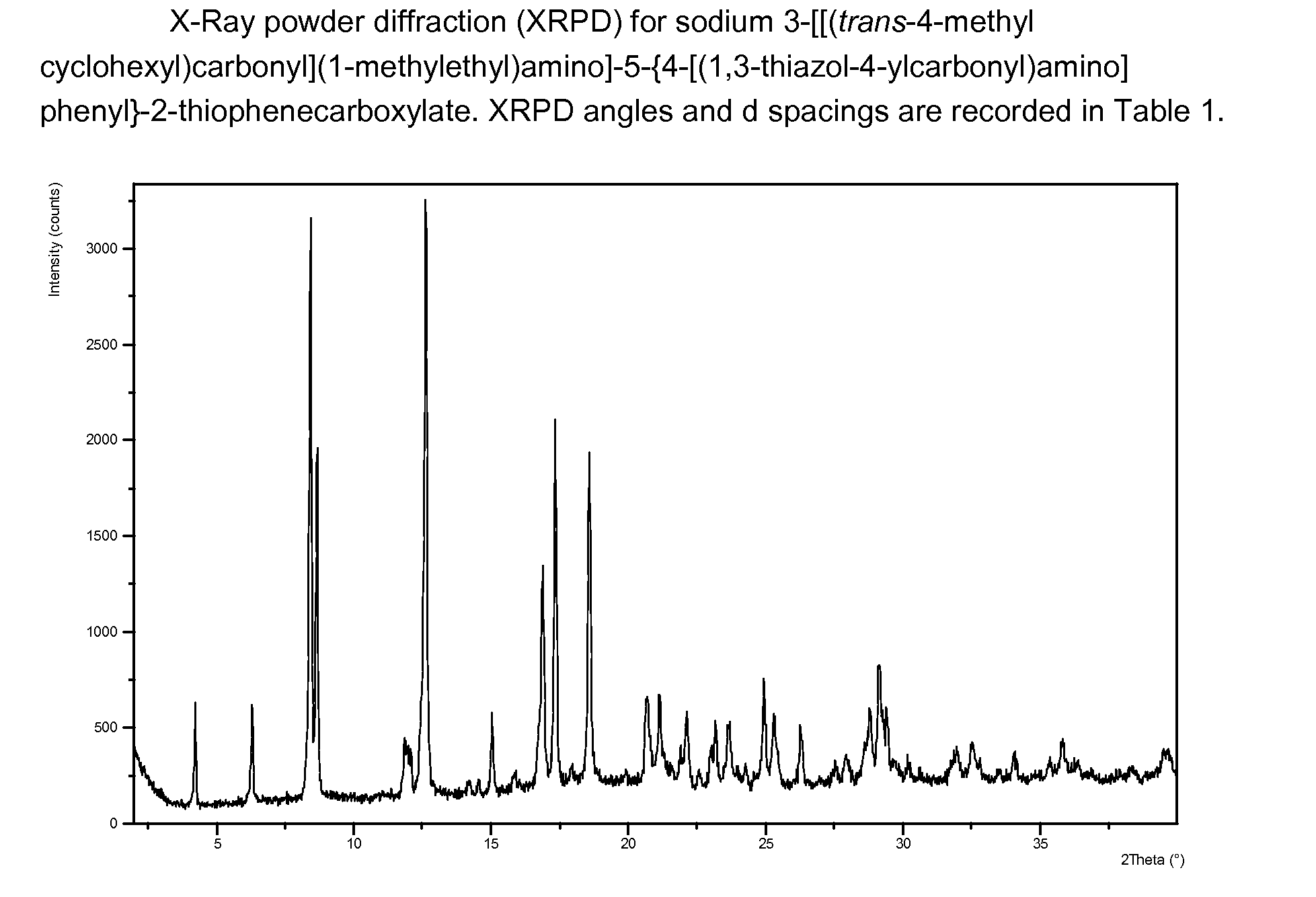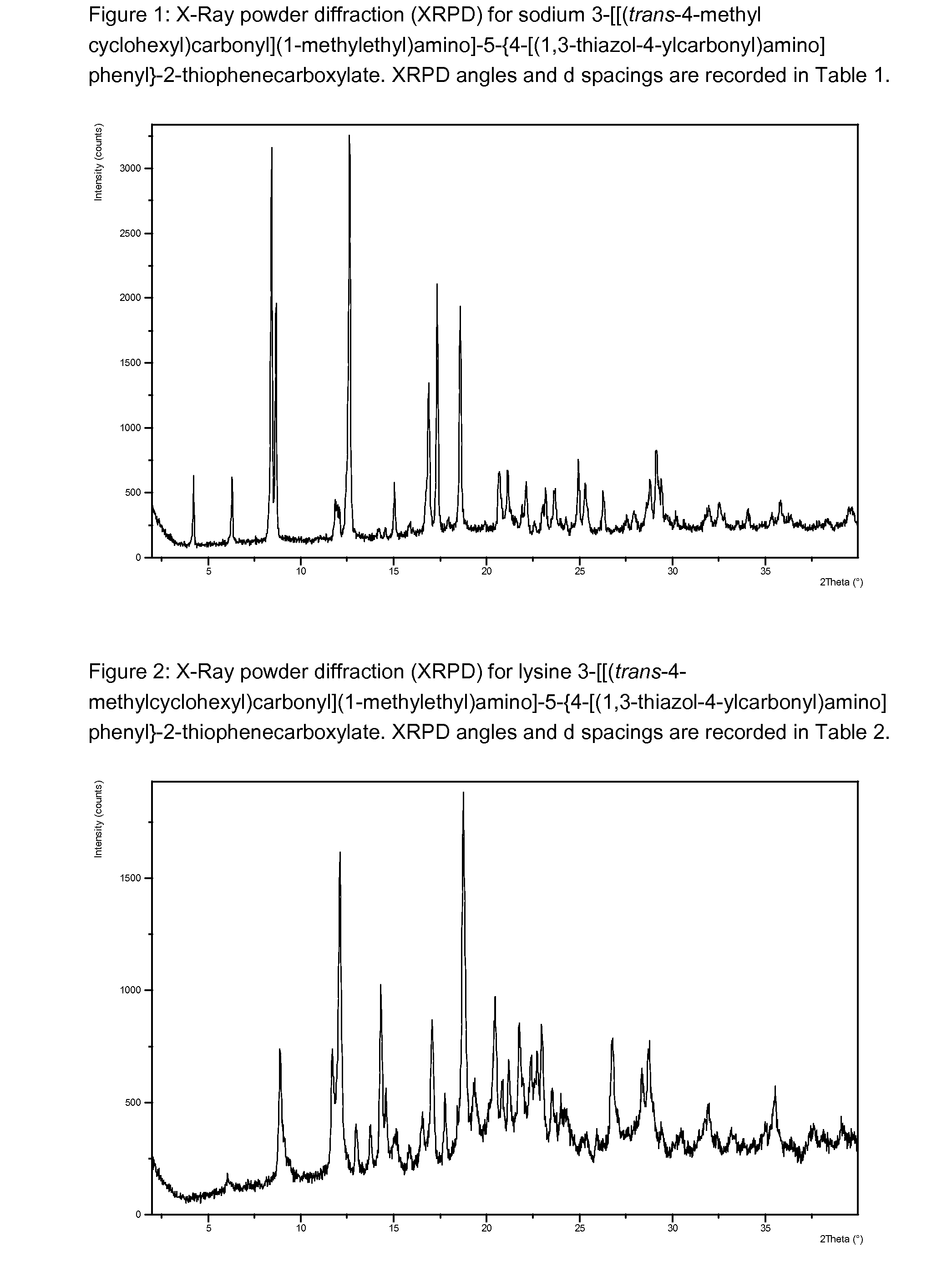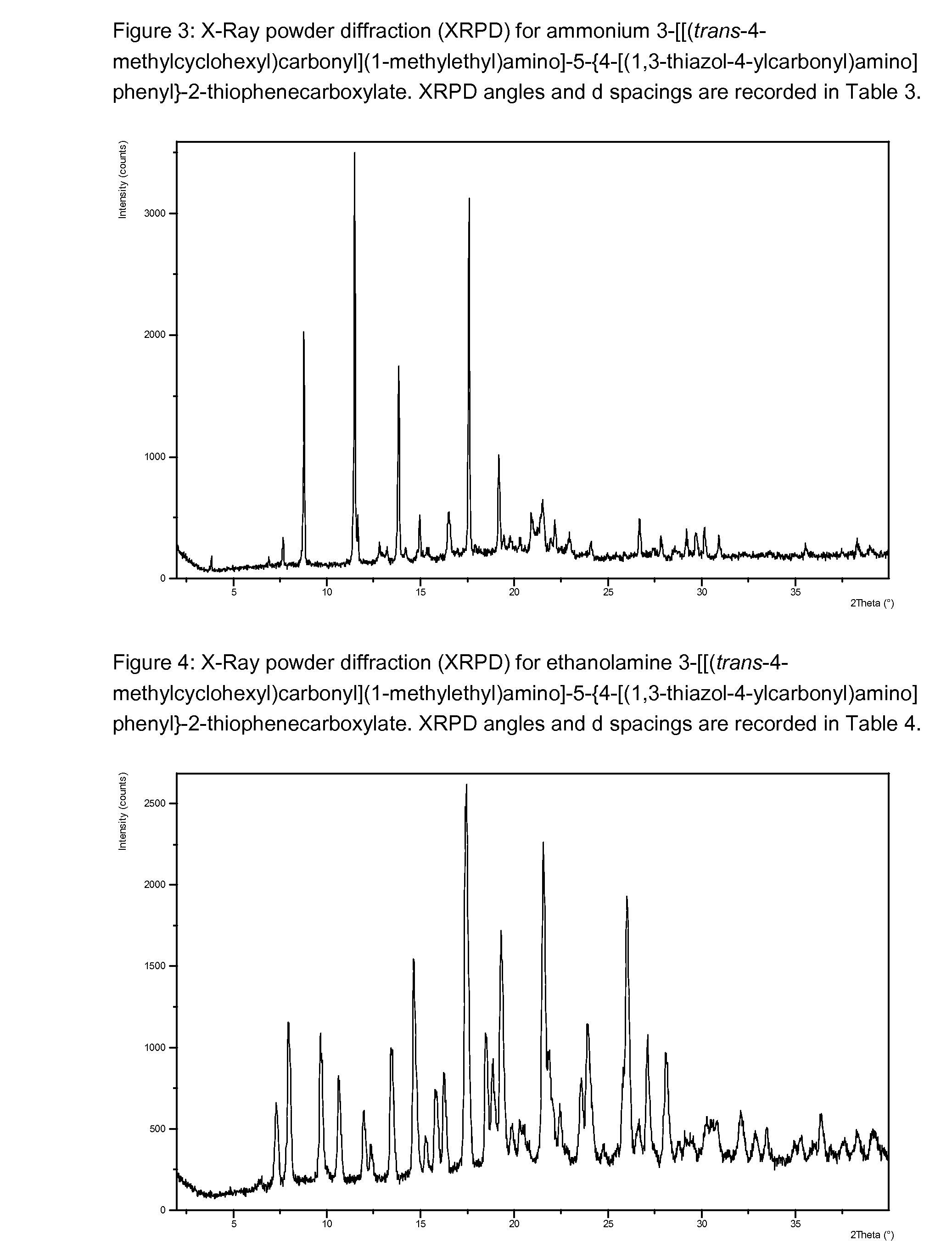2-carboxy thiophene derivatives as anti viral agents
a technology of carboxythiophene and derivatives, which is applied in the field of novelties, can solve the problems of hcv genotype, inability to develop a vaccine in the near future, and inability to achieve the effect of antiviral therapy
- Summary
- Abstract
- Description
- Claims
- Application Information
AI Technical Summary
Problems solved by technology
Method used
Image
Examples
example 1
3-[[(trans-4-Methylcyclohexyl)carbonyl](1-methylethyl)amino]-5-{4-[(1,3-thiazol-4-ylcarbonyl)amino]phenyl}-2-thiophenecarboxylic acid
[0790]
[0791]Intermediate 6 (310 mg) was dissolved in MeOH (3 mL) and THF (3 mL). 2N Sodium hydroxide solution (2 mL) was added and the reaction mixture was stirred at room temperature overnight. The mixture was diluted with DCM (15 mL) and 2N HCl (5 mL) was added. The mixture was stirred at room temperature for 30 mins. The organic phases were separated using a hydrophobic frit, and were evaporated in vacuo. The residue was purified by NH2 SPE cartridge, eluting with MeOH (×5 volumes), and 10% 2N HCl in MeOH to give the title compound.
[0792]MS calcd for (C26H29N3O4S2+H)+: 512
[0793]MS found (electrospray): (M+H)+=512
[0794]1H NMR (CDCl3): δ 9.44 (1H, s), 8.86 (1H, d), 8.35 (1H, d), 7.86 (2H, d), 7.69 (2H, d), 7.08 (1H, s), 5.05-4.93 (1H, m), 2.16-2.02 (1H, m), 1.79-1.55 (5H, m), 1.54-1.27 (2H, m), 1.24 (3H, d), 1.01 (3H, d), 0.79 (3H, d), 0.77-0.59 (2H, ...
example 2
Sodium 3-[[(trans-4-methylcyclohexyl)carbonyl](1-methylethyl)amino]-5-{4-[(1,3-thiazol-4-ylcarbonyl)amino]phenyl}-2-thiophenecarboxylate
[0795]
[0796]3-[[(trans-4-Methylcyclohexyl)carbonyl](1-methylethyl)amino]-5-{4-[(1,3-thiazol-4-ylcarbonyl)amino]phenyl}-2-thiophenecarboxylic acid (492 mg, a synthesis of which is described as Example 1) was dissolved in isopropanol (10 mL) with heating. 0.496 N Sodium hydroxide solution (2.04 mL) was added and the reaction mixture was left stirring at room temperature for 3 days. A solid precipitated out and this was collected by vacuum filtration. The solid was washed with ice cold isopropanol / water (5:1) and was collected and dried at 50° C. under vacuum for 4 h to give the title compound.
[0797]MS calcd for (C26H28N3O4S2+H)+: 512
[0798]MS found (electrospray): (M+H)+=512
[0799]1H NMR (d6-DMSO): δ 10.46 (1H, s), 9.28 (1H, d), 8.53 (1H, d), 7.91 (2H, d), 7.64 (2H, d), 7.10 (1H, s), 4.67 (1H, quintet), 2.14 (1H, tt), 1.81 (1H, d), 1.61-1.48 (3H, m), 1....
example 3
3-[[(trans-4-Methylcyclohexyl)carbonyl](1-methylethyl)amino]-5-{4-[(2-pyridinylcarbonyl)amino]phenyl}-2-thiophenecarboxylic acid
[0801]
[0802]To a solution of Intermediate 10 (195 mg) in THF / MeOH (1:1, 6 mL) was added 2N sodium hydroxide (2 mL) and the reaction was stirred at room temperature for 18 h. DCM was added and the mixture was acidified with 2N HCl to pH 5.5 (using a pH meter). The organic phases were separated using a hydrophobic frit and were passed through a SCX SPE cartridge, eluting with DCM followed by MeOH. The fractions were evaporated in vacuo to give the title compound.
[0803]MS calcd for (C28H31N3O4S+H)+: 506
[0804]MS found (electrospray): (M+H)+=506
[0805]1H NMR (CD3OD): δ 8.72 (1H, d), 8.23 (1H, dt), 8.04 (1H, dt), 7.93 (2H, d), 7.76 (2H, d), 7.65-7.60 (1H, m), 7.33 (1H, s), 4.83 (1H, m, obscured by water peak), 2.11 (1H, tt), 1.80-1.49 (5H, m), 1.44-1.18 (5H, m), 1.00 (3H, d), 0.80-0.55 (5H, m), 2 exchangeable protons not seen.
PUM
| Property | Measurement | Unit |
|---|---|---|
| temperature | aaaaa | aaaaa |
| temperature | aaaaa | aaaaa |
| temperature | aaaaa | aaaaa |
Abstract
Description
Claims
Application Information
 Login to View More
Login to View More - R&D
- Intellectual Property
- Life Sciences
- Materials
- Tech Scout
- Unparalleled Data Quality
- Higher Quality Content
- 60% Fewer Hallucinations
Browse by: Latest US Patents, China's latest patents, Technical Efficacy Thesaurus, Application Domain, Technology Topic, Popular Technical Reports.
© 2025 PatSnap. All rights reserved.Legal|Privacy policy|Modern Slavery Act Transparency Statement|Sitemap|About US| Contact US: help@patsnap.com



